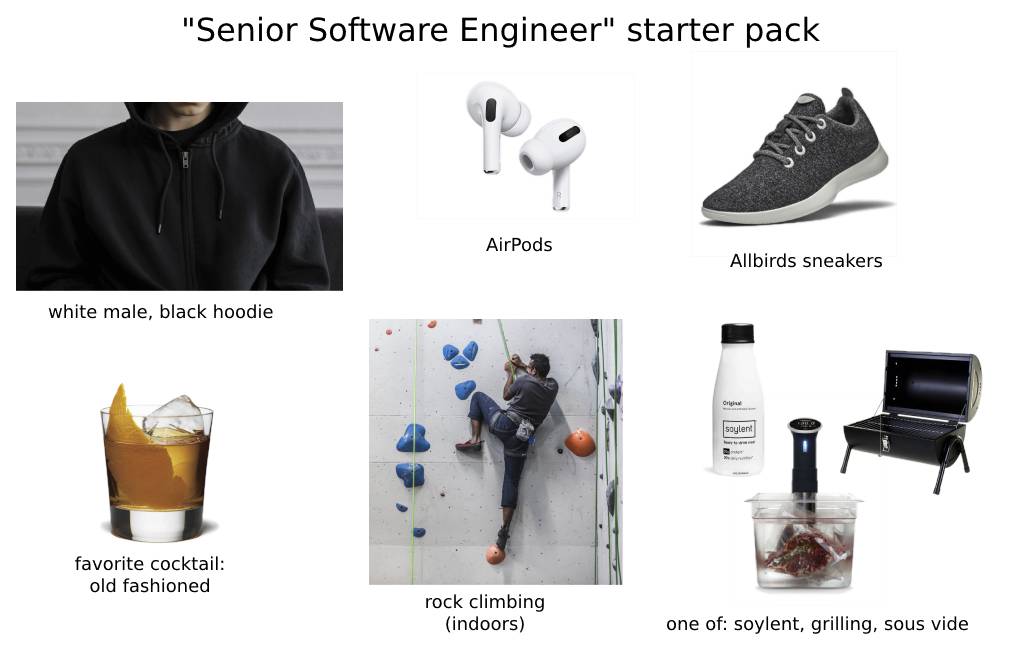It’s well known by this point that tech is a white, male-dominated field. I am sure you can think of many, many reasons why this is a problem, and why diversity is important. It is - correctly! - a common topic of conversation these days.
I am going to discuss one framing in this article. There are many others, and I am not saying this is the only framing, or the best framing, or the only one worth considering. It’s just one way of thinking about diversity in hiring.
We have all met the archetypal “Senior Software Engineer”:

Also has potential to be one of Camille Fournier's "brilliant jerks".
It’s important to say at this point: this is not a bad person! But if you hire all of the same person, things are going to go great until you are left behind because you built an echo chamber. A startup can consist entirely of clones of this guy; you can get your seed funding like this. But you can’t make a grown-up, professional software engineering organisation with entirely this guy - and as you make that transition, if all you have is this guy, he’s prone to turn from an asset into a liability*.
*Because he’s too enamoured with his own success, he’ll be rigid in his conception of tech / development methodology / what the product should be / something else, and will try to throw around his tenure and experience to get his way. I’ve seen this happen, and it’s an excellent way to kill a team’s morale.
So you want two things: more diversity and good candidates. The problem is twofold: most of the obvious “merit-based” evaluation criteria are subtly biased. But even with perfectly unbiased evaluation criteria, the pipeline itself is biased! So unbiased evaluation is still going to get you biased hires.
How not to think about diversity in hiring
So what’s the solution? Is it this?


I call this the “multi-ethnic rainbow team photo” and it is not fooling anyone. This somehow manages to be not inclusive of a large number of people, while also being tokenising at the same time. The person responsible for this mistake is most likely either the man on the far right or the blonde lady in the middle. (They probably walked through the office and pulled these people away from their actual work in order to stage this picture for the careers page.)
If this is what you have in mind when you’re hiring, then your hiring practices end up something like “given two otherwise-equal candidates, pick the POC, or the one who doesn’t identify as male”.
This is effectively using underrepresented people as a means to an end - which is the kind of gross that you should be trying to avoid. Not only is it gross, but you’re in shaky legal territory: employers are permitted to run affirmative action programs, but you have to hit specific measures in order to not be in breach of Title VII. In my view this is just not the right approach.
Hiring for difference
There’s a different approach you can take: examine where your current workforce is self-similar, and hire to introduce difference.
Now, you might say “our engineers are whip-smart, collaborate well, show incredible initiative, and can turn around fixes and enhancements in record time”. Well done! So now: hire some junior engineers, possibly even ones with limited programming experience. That will teach your existing engineers mentorship, and how to balance immediate needs vs. modelling good practices for long-term benefit. This will not only benefit your new hires, but will also grow your existing engineers: it is through those interactions with different perspectives that they’ll learn new skills.
More typically, hiring for difference means explicitly prioritising collaborative skills and emotional maturity, even ahead of technical experience. A focus on deft interpersonal skills will push back against any “brilliant jerks are worth it” mindsets that may be lurking in your organization.
When you reprioritise what you’re looking for, you end up hiring different kinds of people. If you do that thoughtfully, and really consider where and how you find your candidates, diversity will come naturally - and you will also have a culture where your hires are valued beyond their ability to fill a quota.